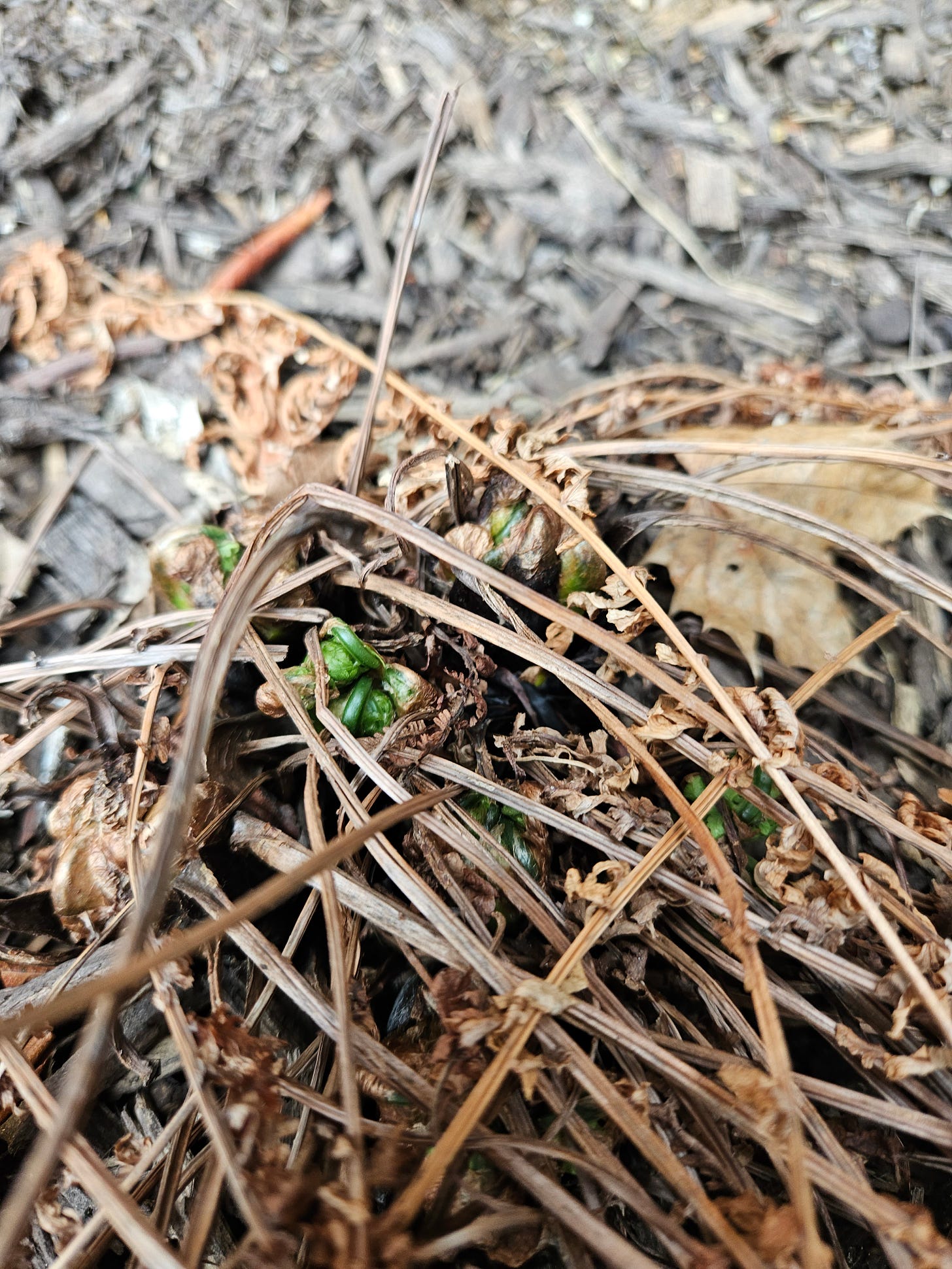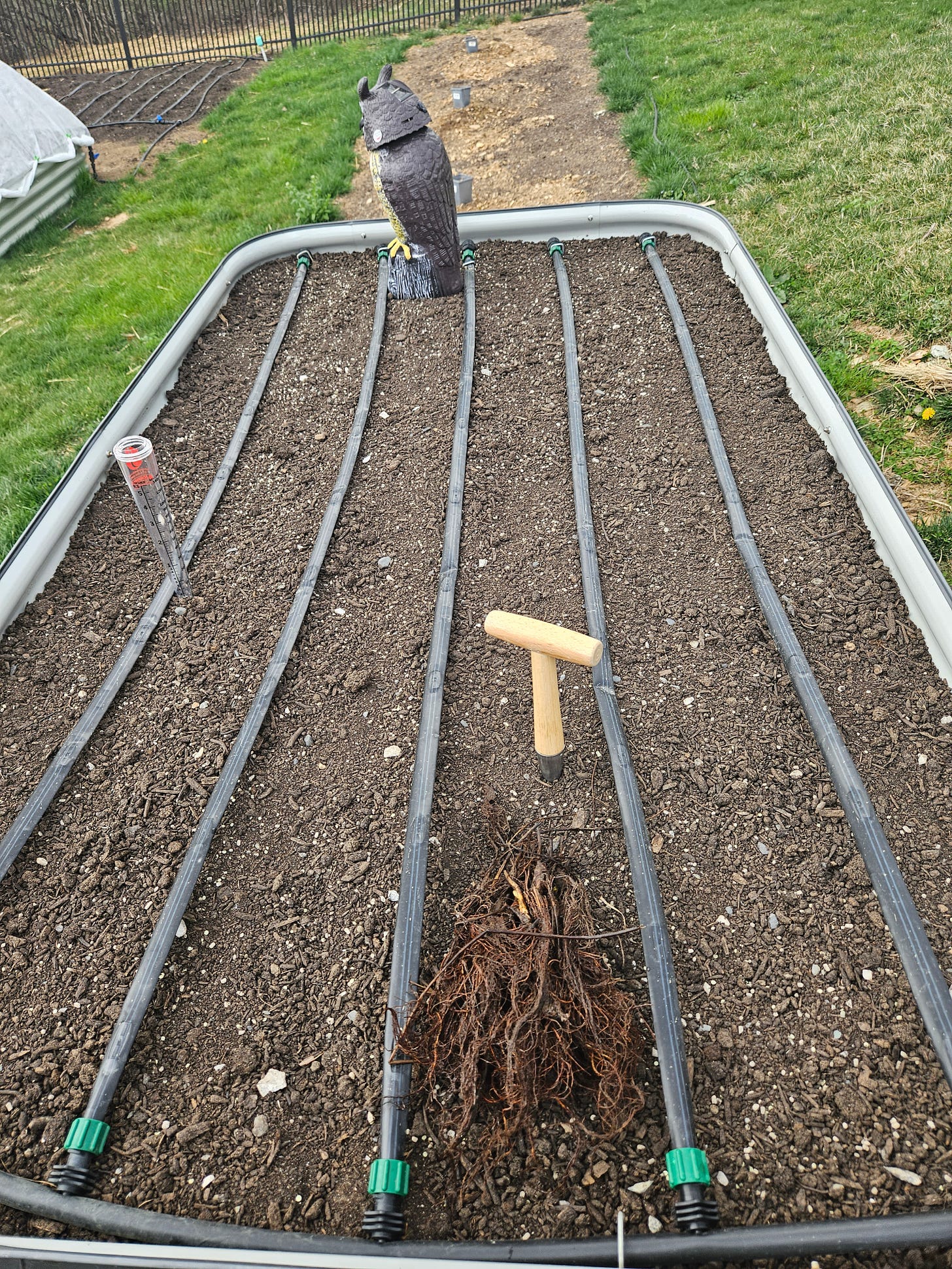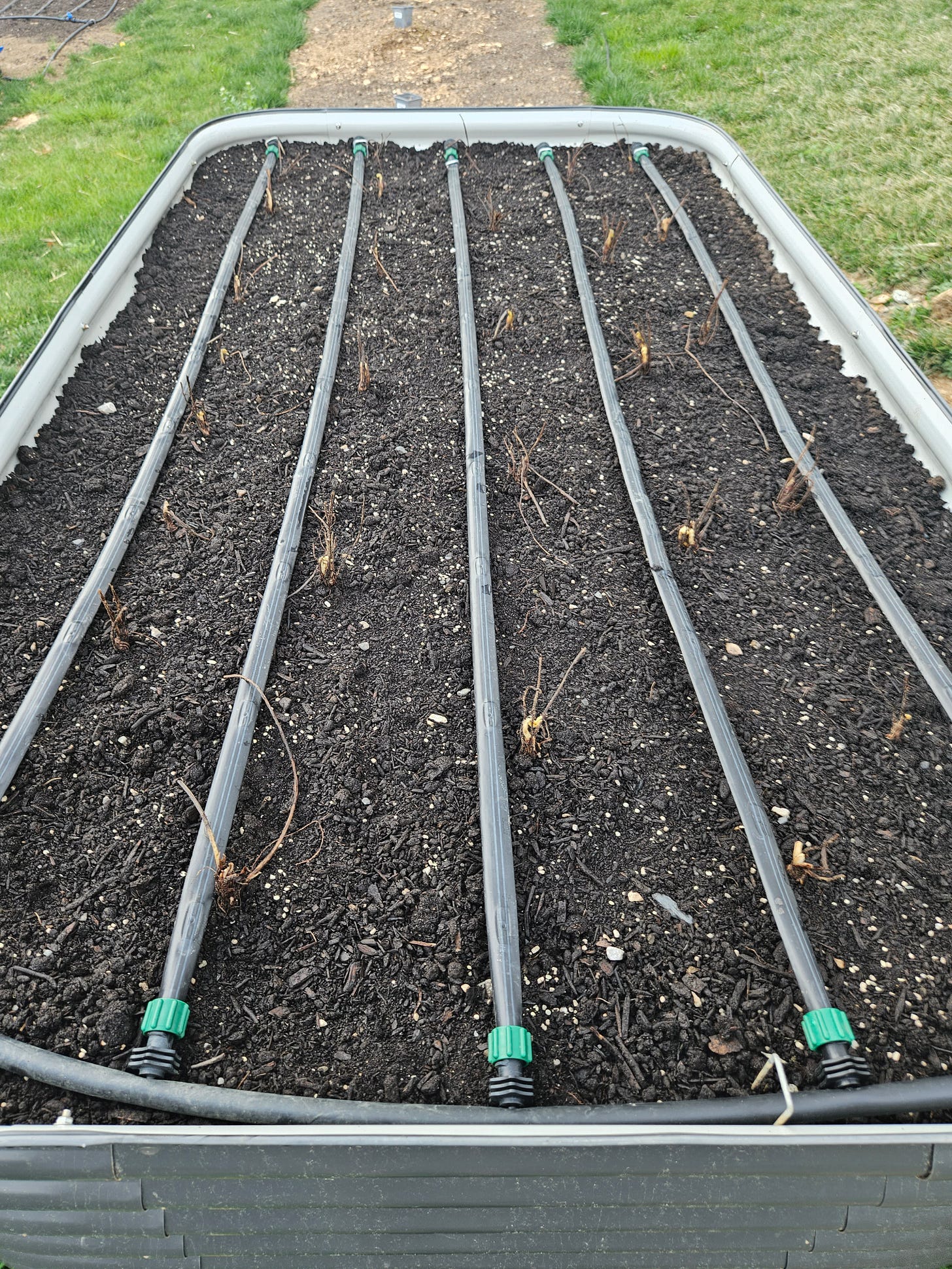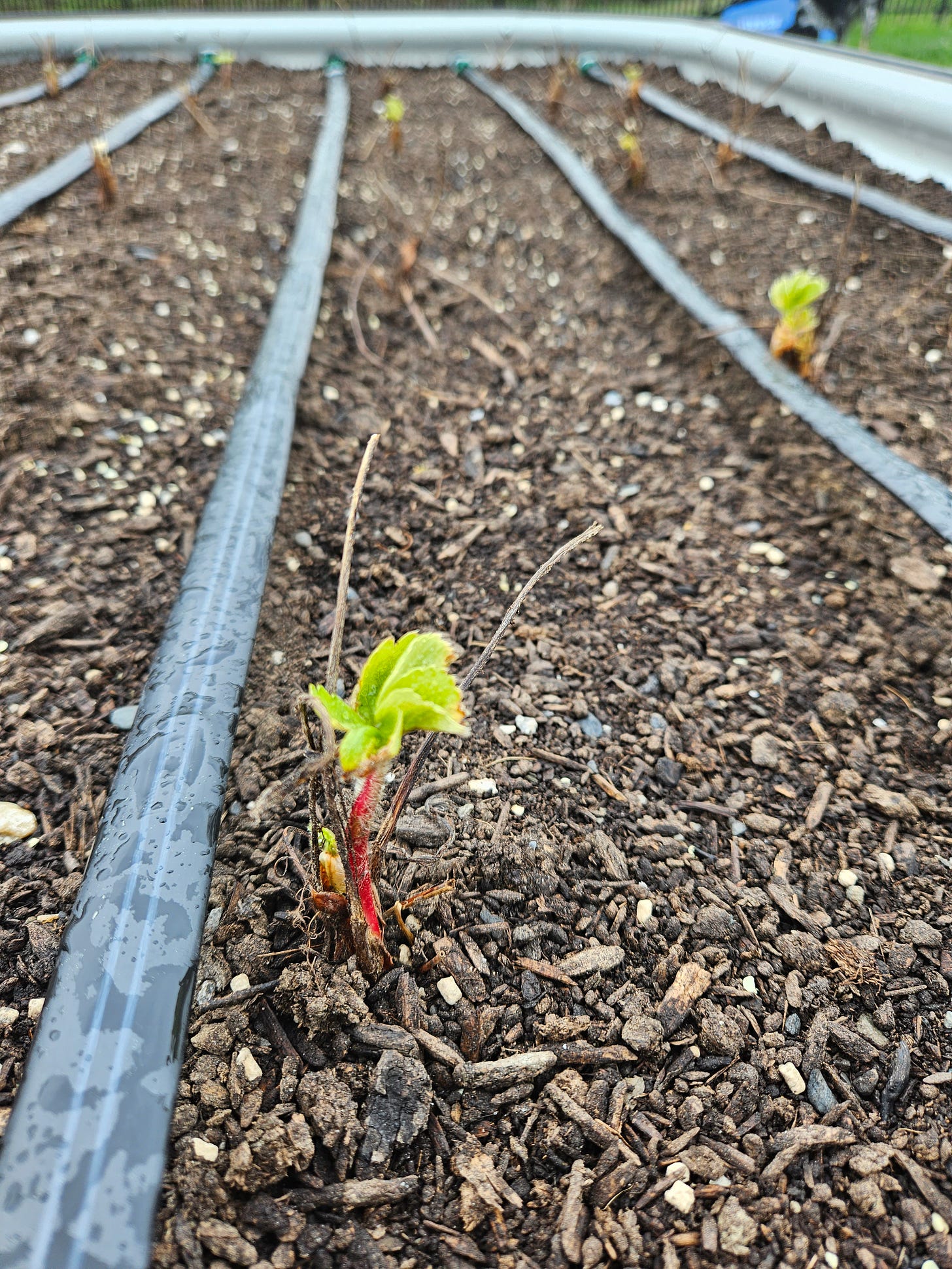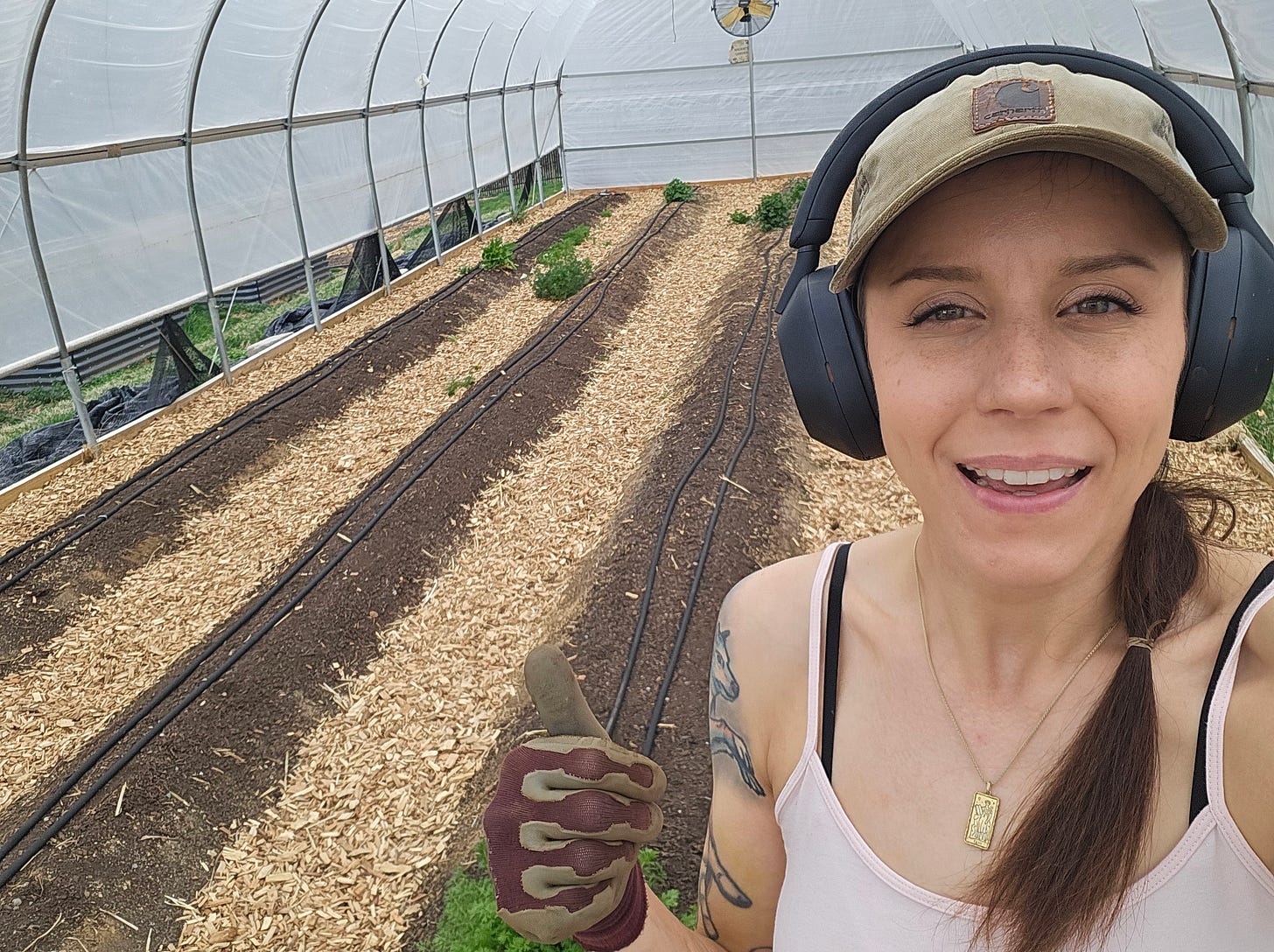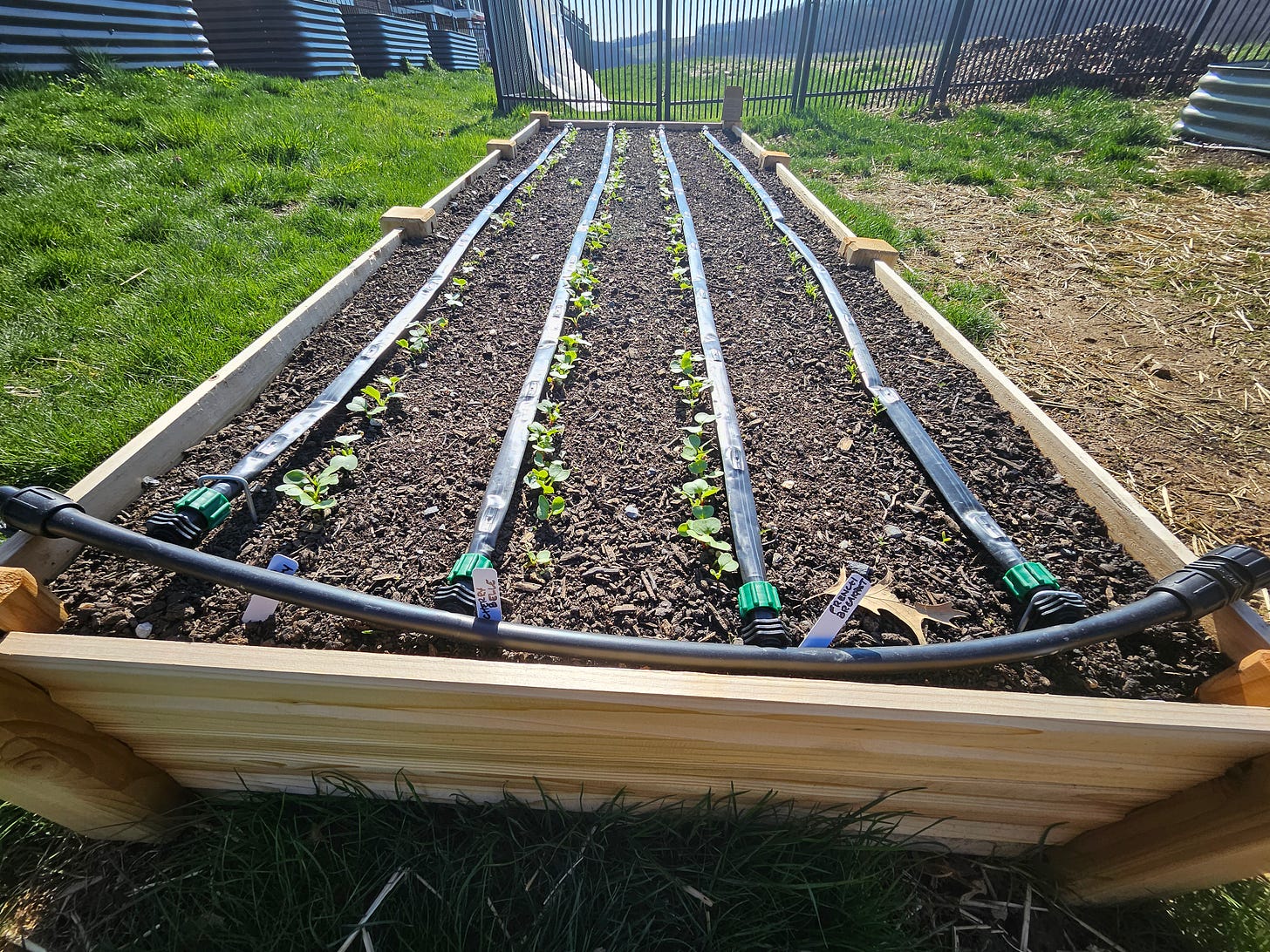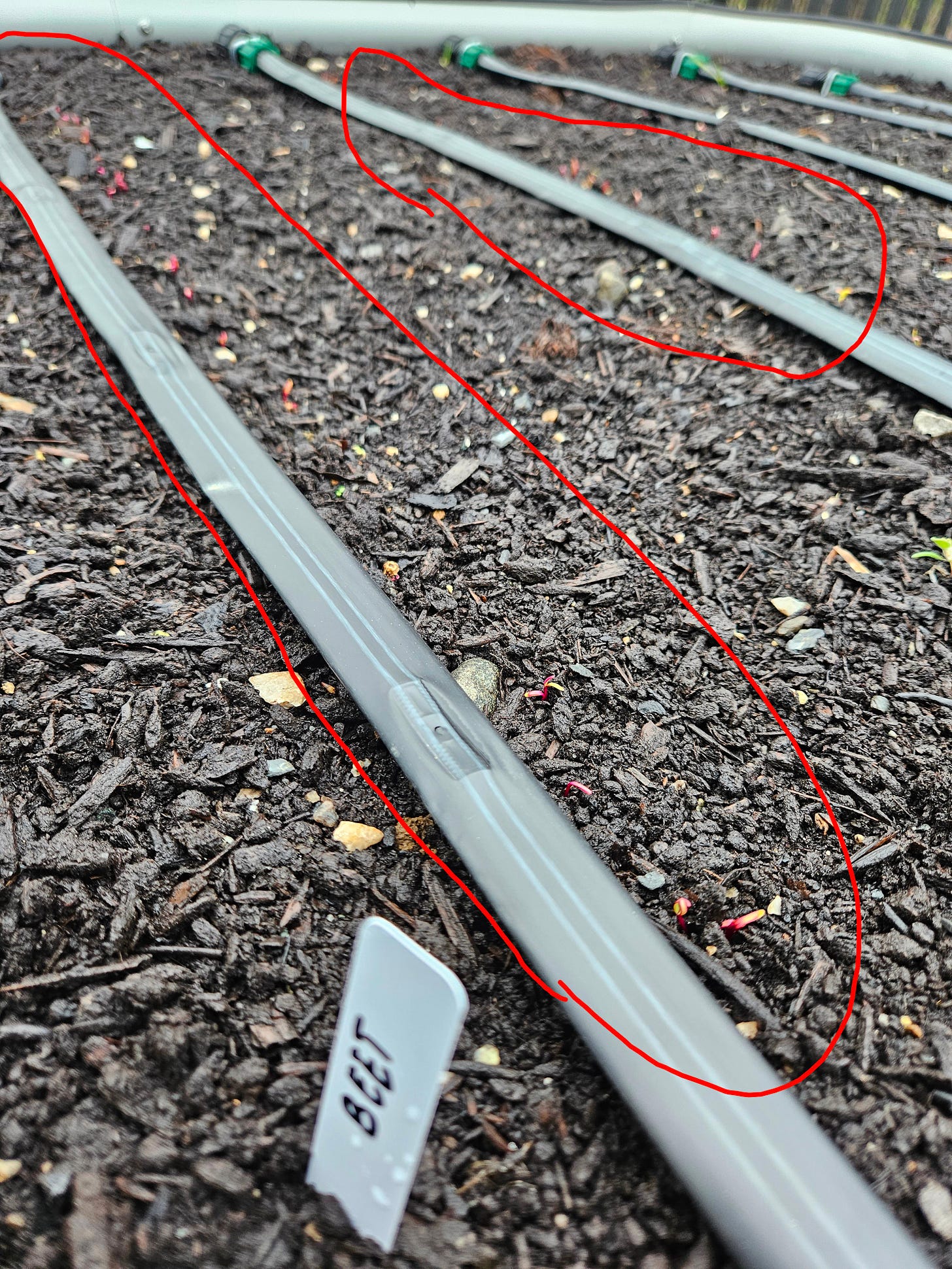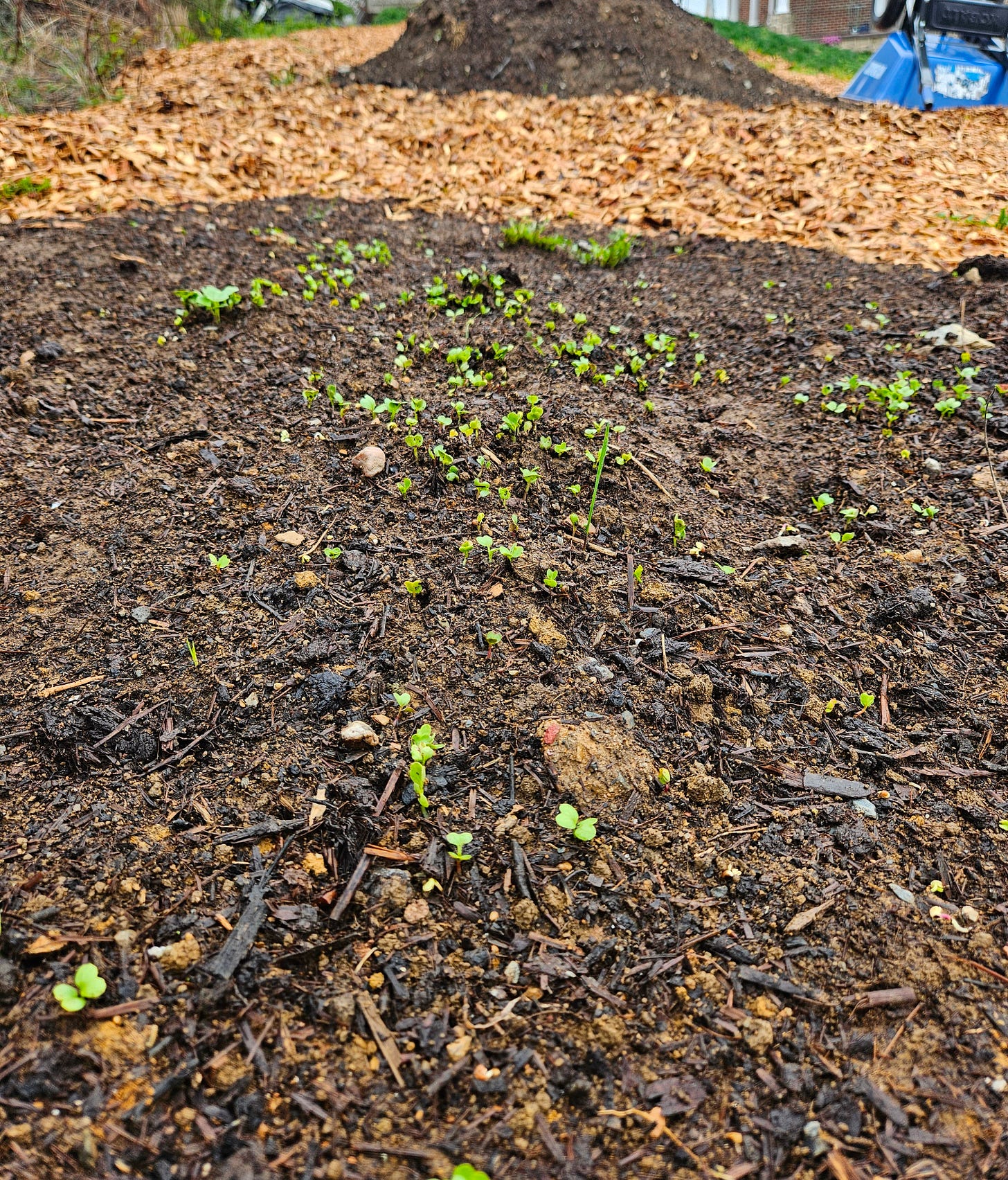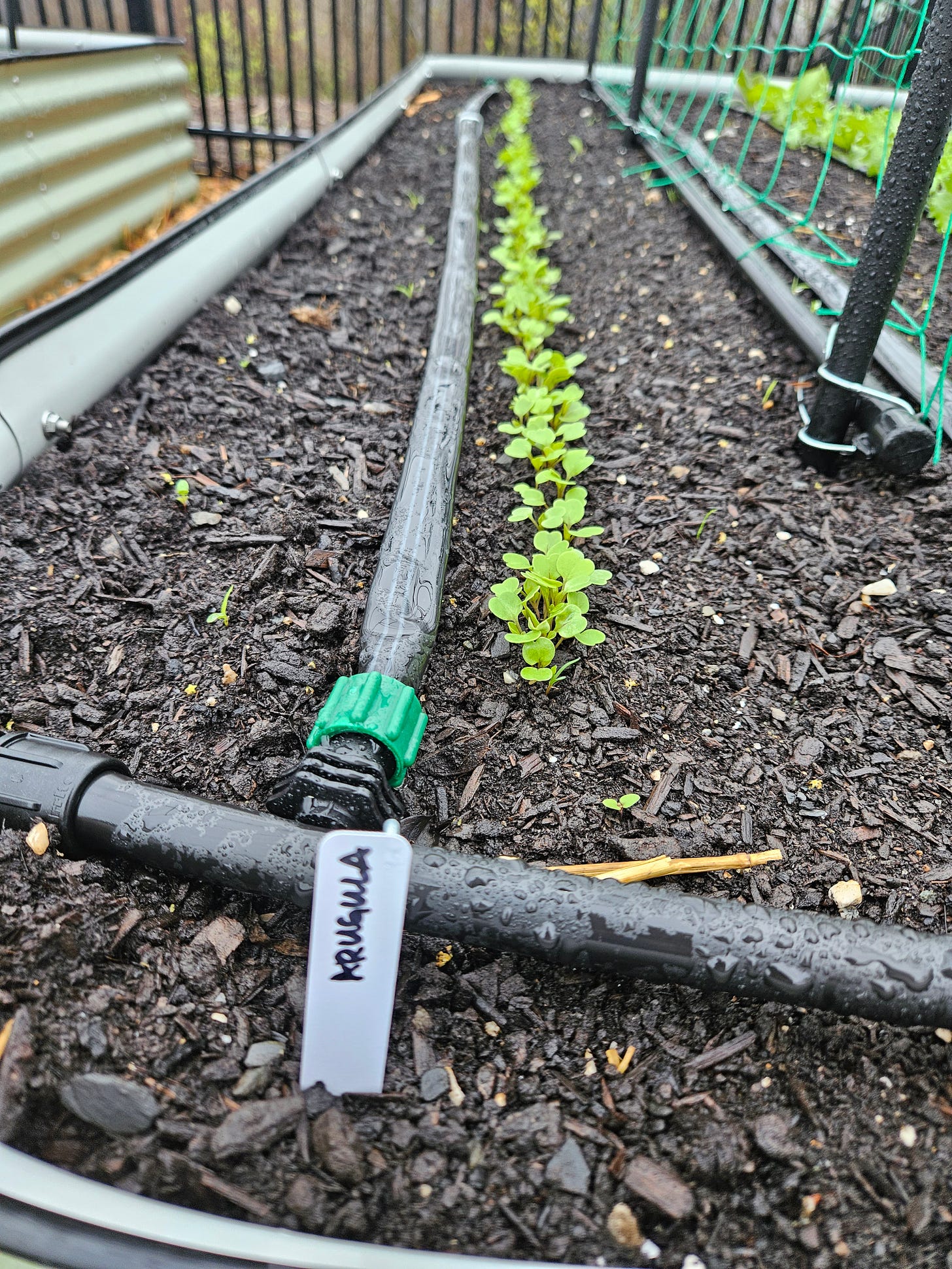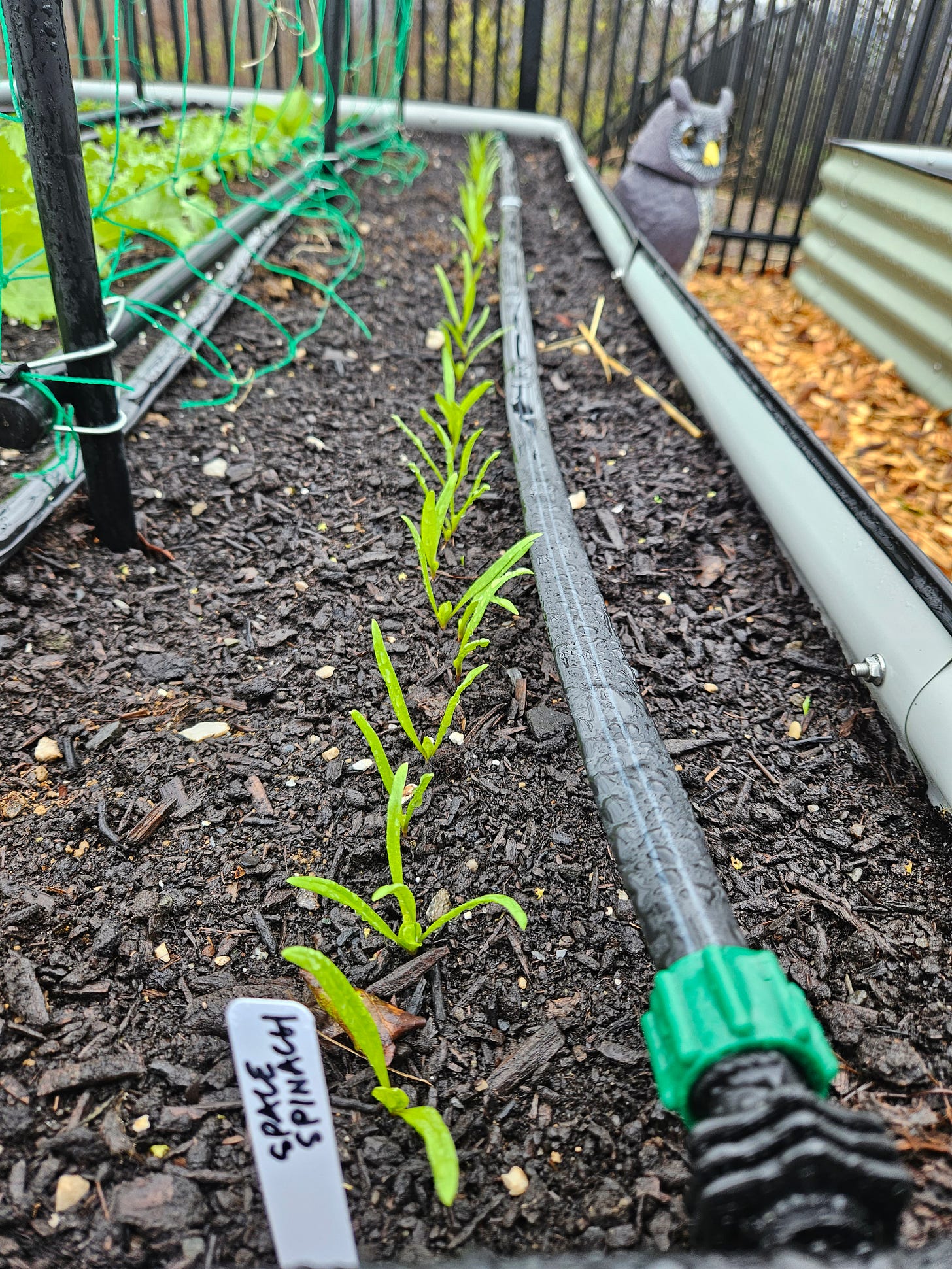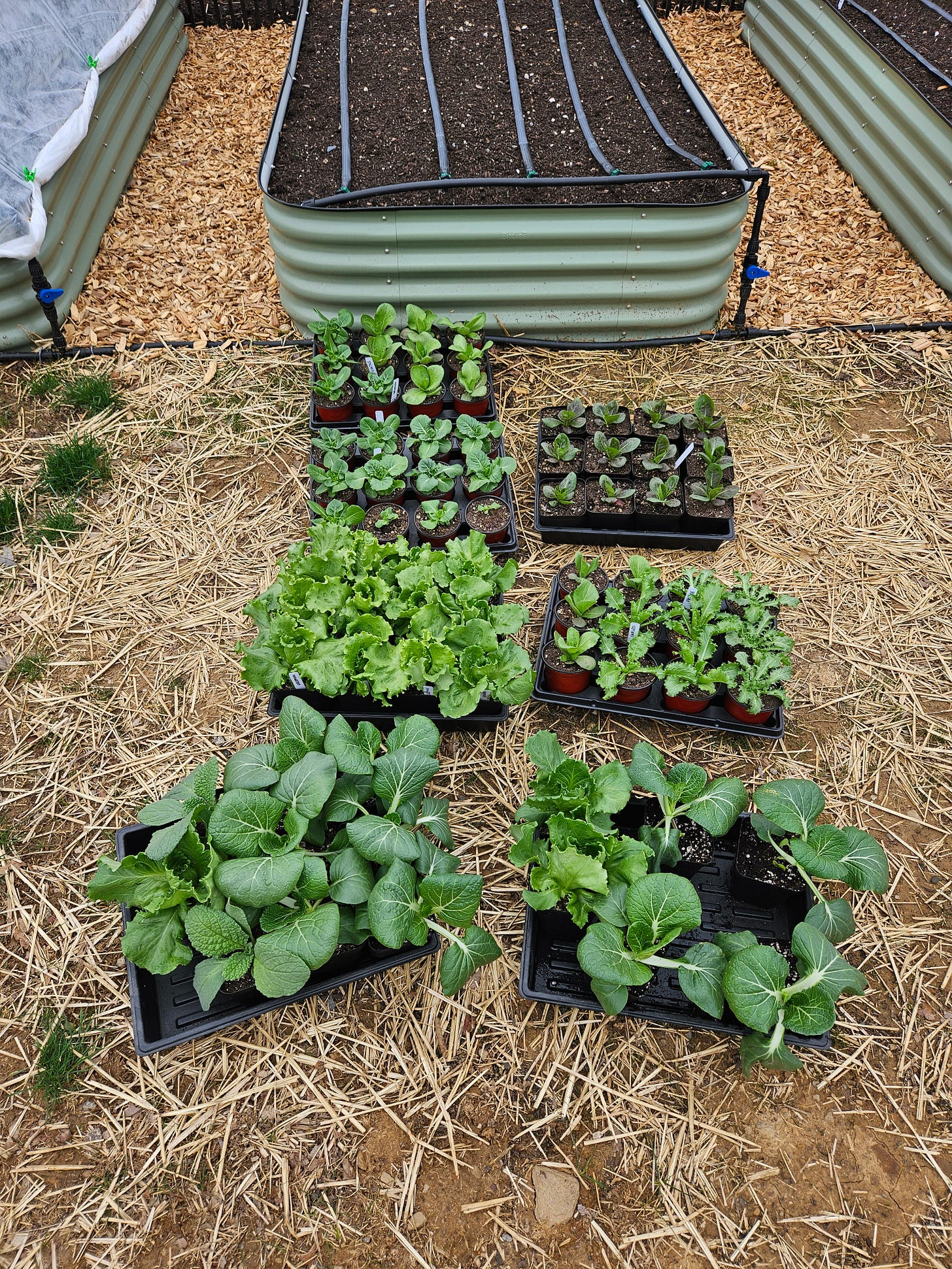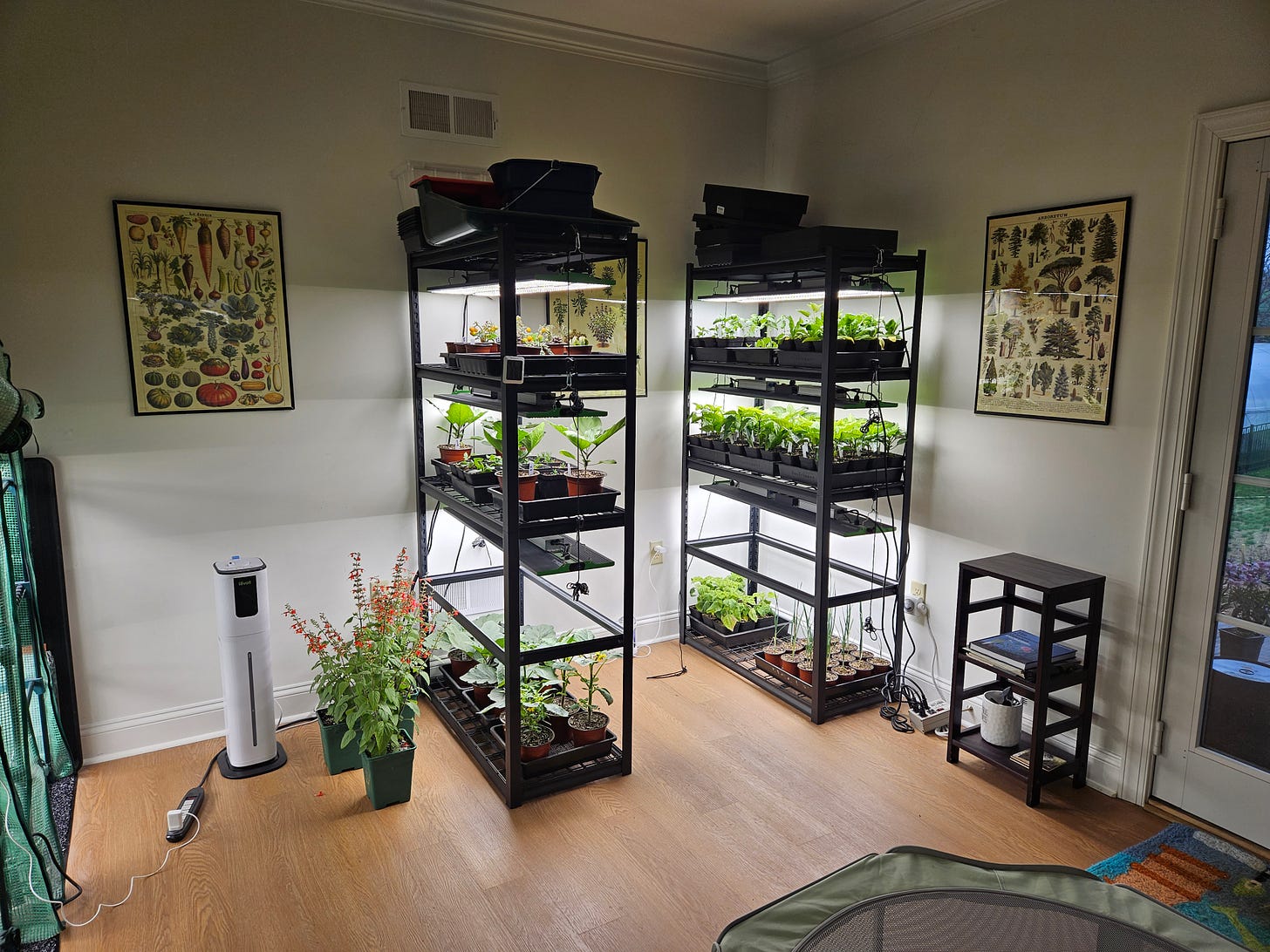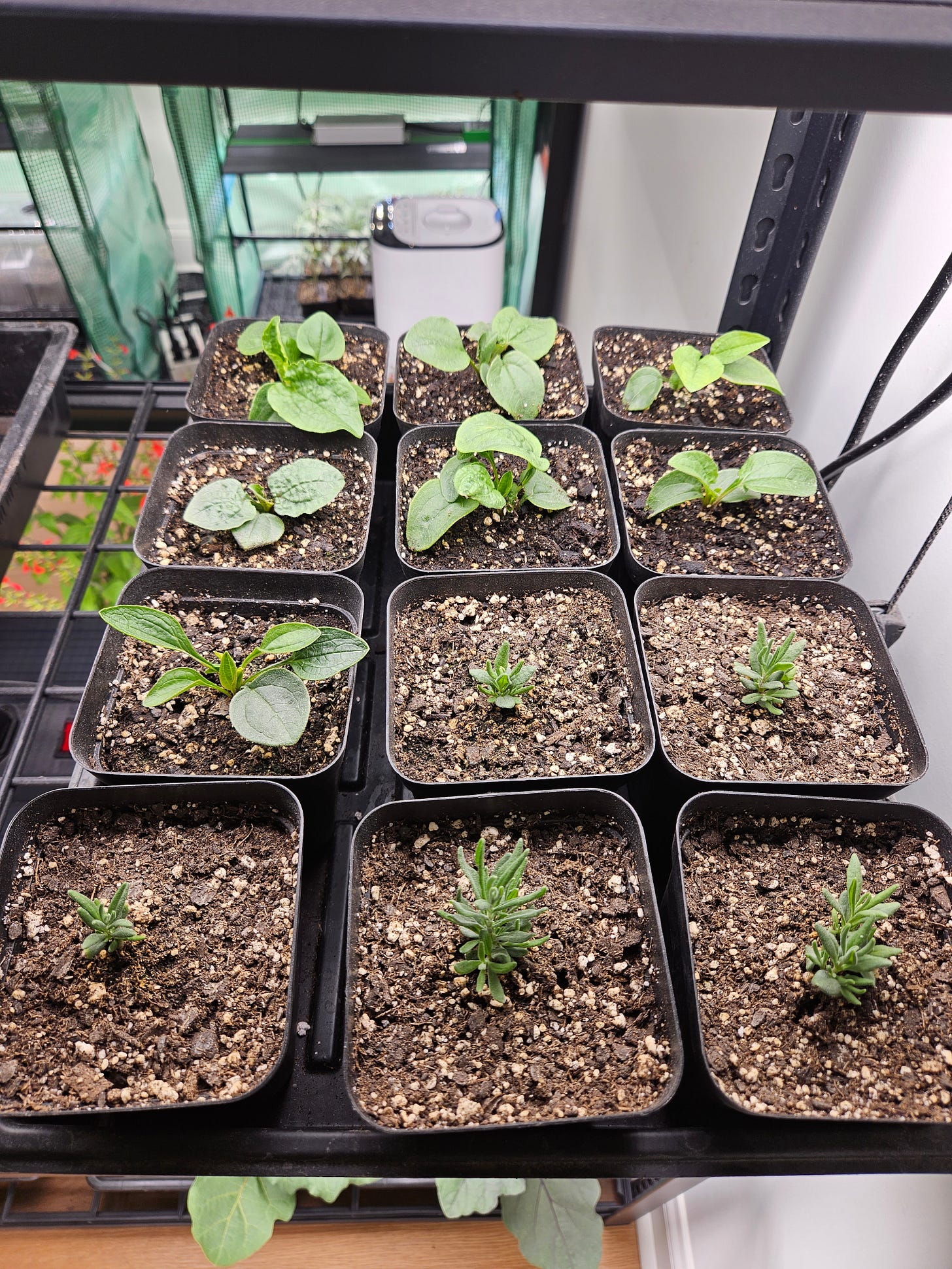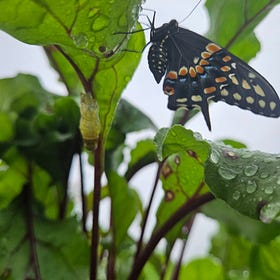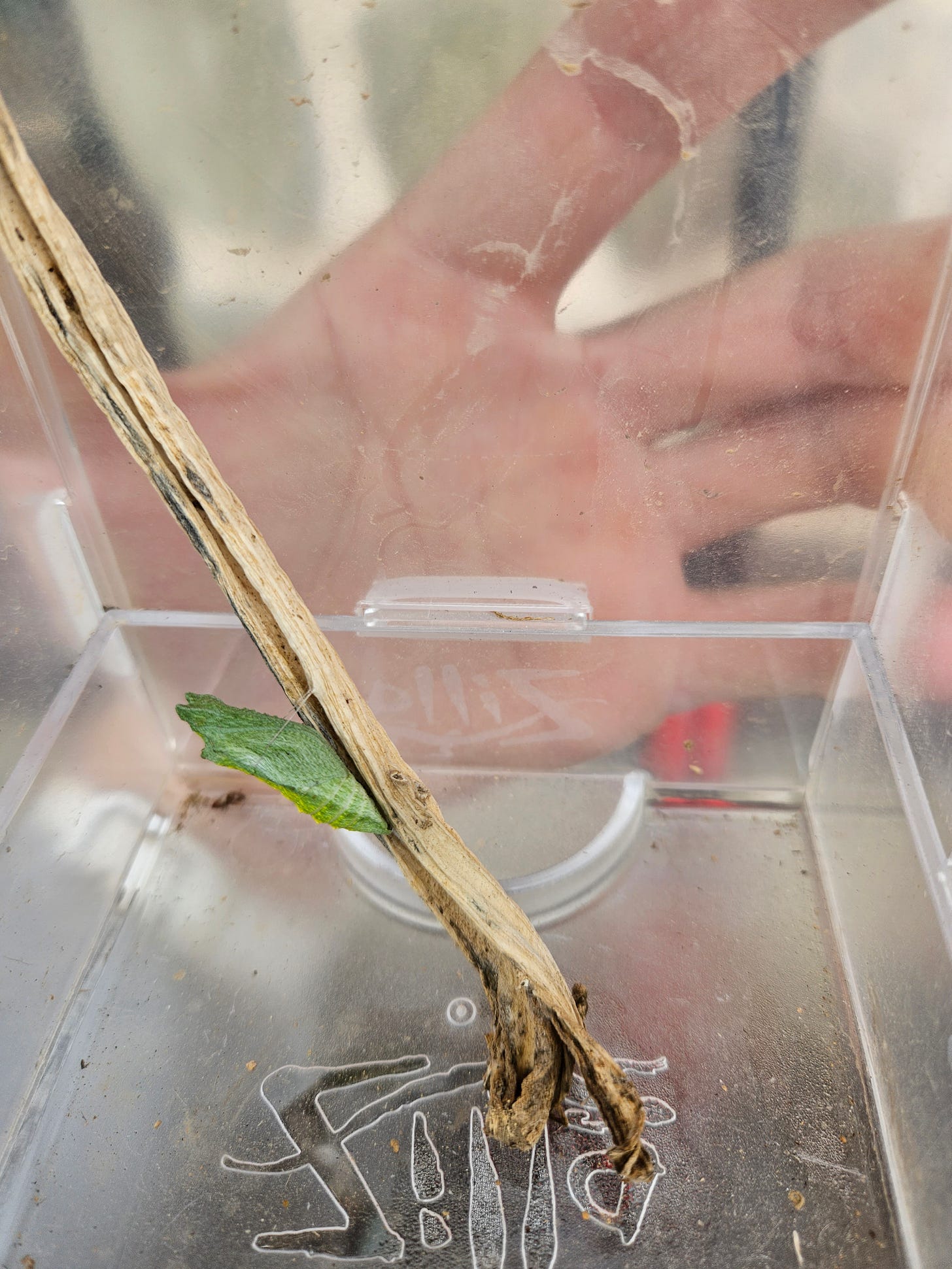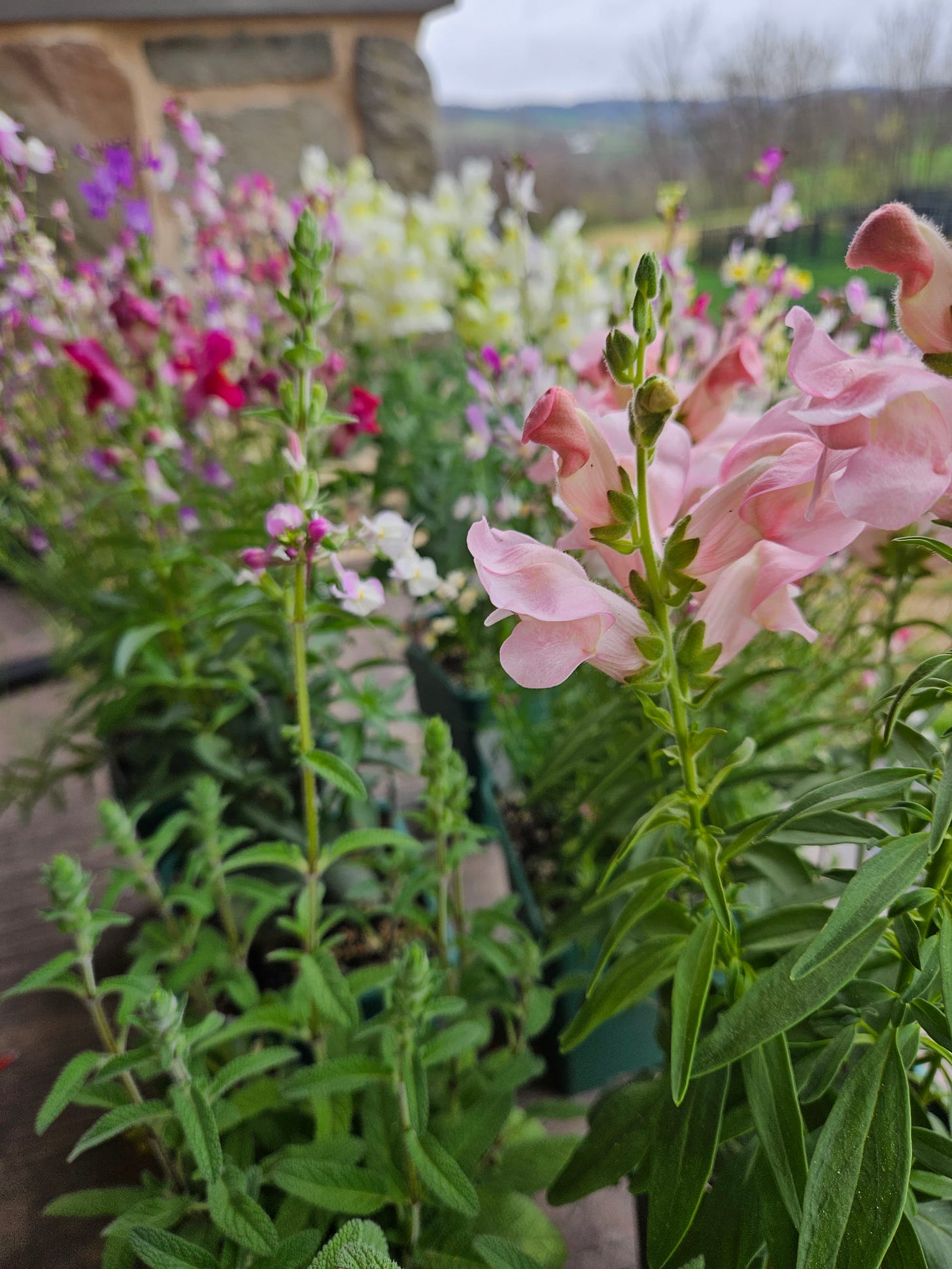Oleri Gardening is completely free to read, and your support means the world to me. If you enjoy what I write, please like, comment, restack, or share—it really helps more than you know! Thank you for choosing to spend some of your time reading my silly garden blog.
The spring frosts are growing lighter by the day and my frost blankets are becoming more and more unnecessary. Soon, they’ll be folded, packed into a bin, and stored in the shed until October. Likewise, the last two weeks have roused many woody and herbaceous perennials out of their dormant states, though not all quite yet.
The magnolias are blooming, hydrangeas are budding, my blueberries are flowering, the ferns are sending up new fronds, and my yarrow and licorice mint plants seem to double in size each day.
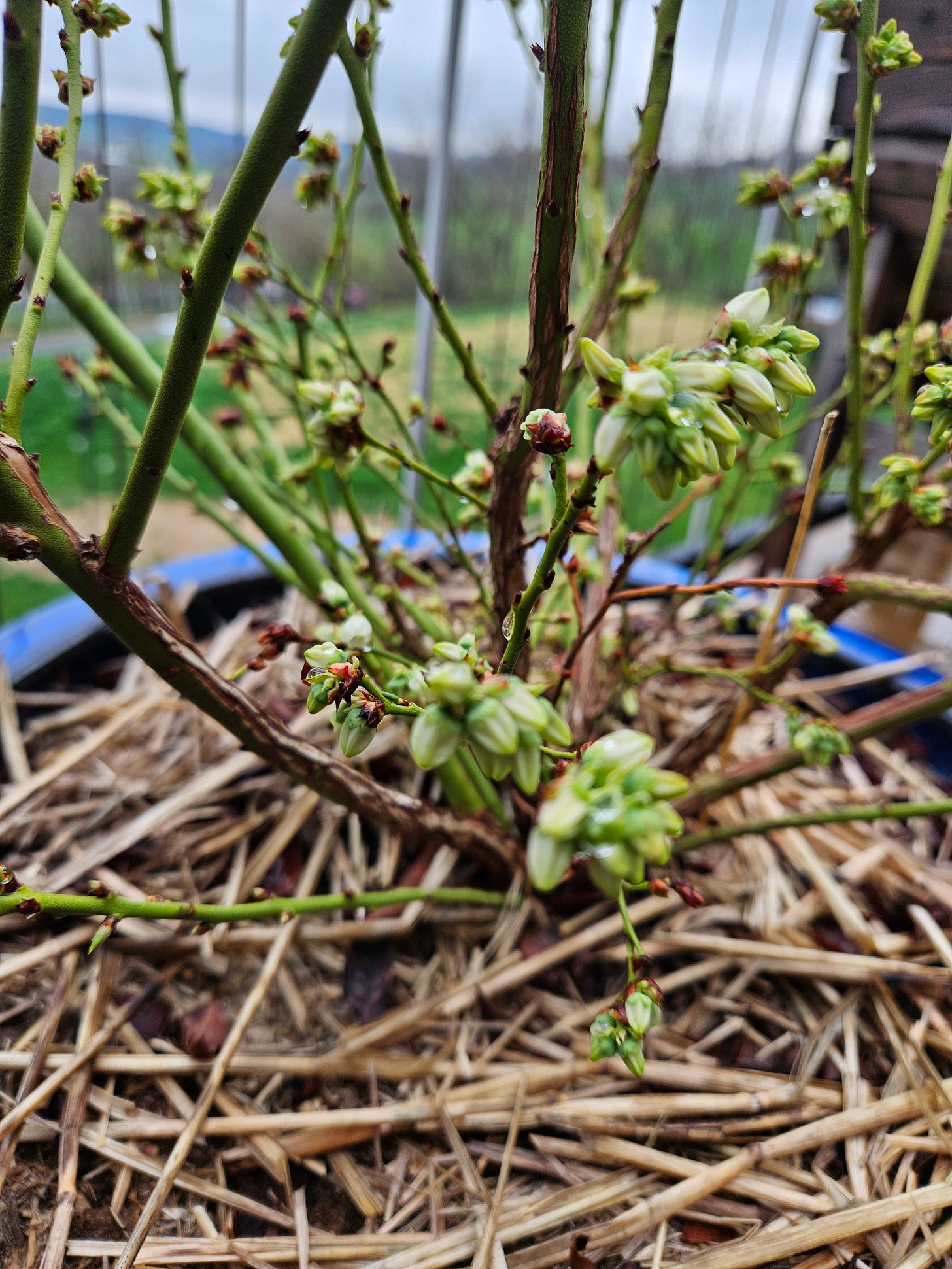
A couple of days ago, we were able to enjoy fresh chives from the herb garden for the first time since November. I also noticed my lavender, thyme, oregano, and sage plants beginning to leaf.
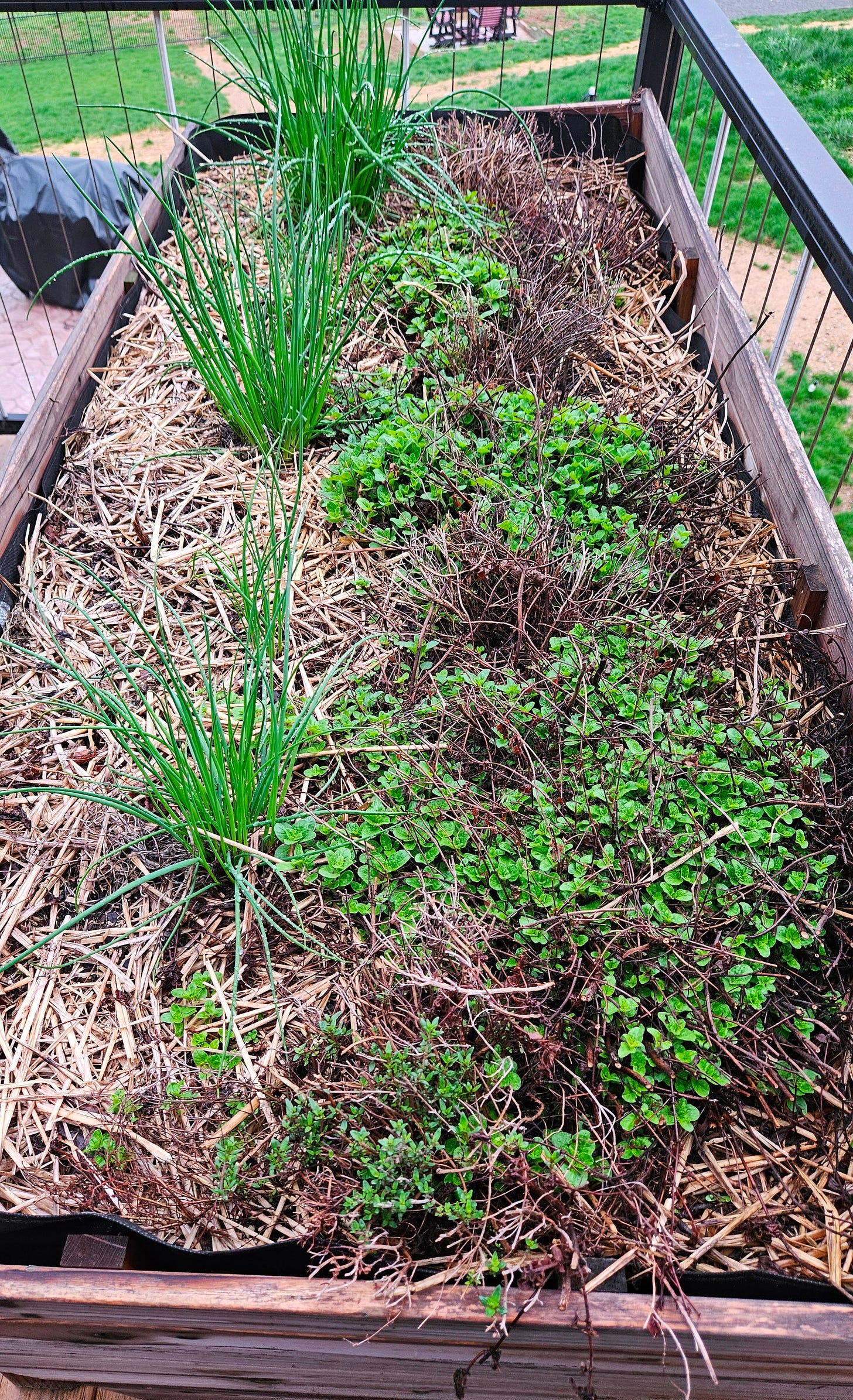
Spring is easily my favorite season.
Since my last post, I’ve finally been able to move some more plants into the garden—some I’ll be able to harvest within the next few weeks, unlike the alliums—and sow even more seeds. The most cold hardy seeds sown outdoors a couple of weeks ago have germinated wonderfully thanks to the steady April showers. I also received and planted my bare-root strawberries, potted up many plants in the nursery, and realized my alliums are outgrowing their row cover already.
It's been a busy time, so let me catch you up on where things stand in the garden today. I'll start with my freshly planted strawberry bed.
Strawberries
Some of you might already know that my 2024 strawberry planting was infected with anthracnose crown rot, which is a fungal disease that causes wilting and, ultimately, death in strawberry plants. The pathogen may have arrived on the bare-root plants, or it might have been lurking dormant in the raised bed soil. Either way, I decided the safest course was to remove and destroy the infected plants, then rotate the crop to a fresh bed. To start over, I ordered 25 new bare-root organic Albion plants from Johnny’s Selected Seeds.
The plants arrived last week, and since it’s important to get strawberries into the ground quickly after delivery, I dropped what I was doing and got straight to work.
First, I removed the ties and gently rinsed the roots with clean water. This step helps hydrate them after shipping and removes any lingering soil, decaying material, or pathogens they might have picked up along the way.
To plant them, I used a long dibbler to make roughly 8-inch-deep holes next to the drip irrigation emitters. The dibbler works well because it creates holes that are just the right width and, more importantly, long enough to fit the roots without them bending. Bending strawberry roots during planting can lead to poor establishment or even death, so I make it a point to keep them straight.
I spaced the plants about 16 inches apart, skipping one emitter between each. A few of the crowns looked a little weak, but I planted them anyway—hopefully, they’ll catch on. If not, I can always fill in the gaps later using runners from the stronger plants.
Once they were in, I gave them a good soak to help them settle in. Conveniently, we got 1.5 inches of rain the following week, so I haven’t had to water them since!
I remember it took a couple of weeks for my plants to start leafing out last year. A few of the new crowns have already pushed out a leaf, but most are still sleeping.
Big Carrot Planting
The last day of March marked the first seeds sown inside the polytunnel. While the bee balm, nigella, catnip, chamomile, and a patch of self-sown cilantro were already getting cozy in there, it felt good to finally plant a big utility crop like carrots.
The weather had been unseasonably warm, but with a cold snap on the horizon, I decided to make the most of the sunshine and got around 1,000 carrot seeds into the leftmost row. This year, I’m growing four main varieties—Napoli, Narvik, Naval, and Dolcivia—with a fifth, purple carrot thrown in for fun.
Napoli will be the first to mature, ready in just 45–55 days. Once I harvest them, I’ll relay plant that section with yellow summer squash and a round, heirloom variety of summer squash called Zapallito Del Tronco. A few weeks later, the Narvik and Naval carrots—each taking about 72 days—will be ready to pull. In their place, I plan to grow zucchini and bush beans. The Dolcivia and purple carrot varieties will stay in as long as they need to, which should be around 90-105 days.
Relay planting summer squashes after carrots is a new strategy I’m trying this year to (hopefully) outsmart the squash vine borer (SVB). These awful pests are most active in early summer. By delaying my squash planting until after the carrots are harvested, I’m aiming to miss the SVB moth’s peak egg-laying window, which is late June to early July—and reduce the damage they do to my plants. I’ll double up on my protection by covering the young plants with pest fabric until they start to produce both male and female flowers.
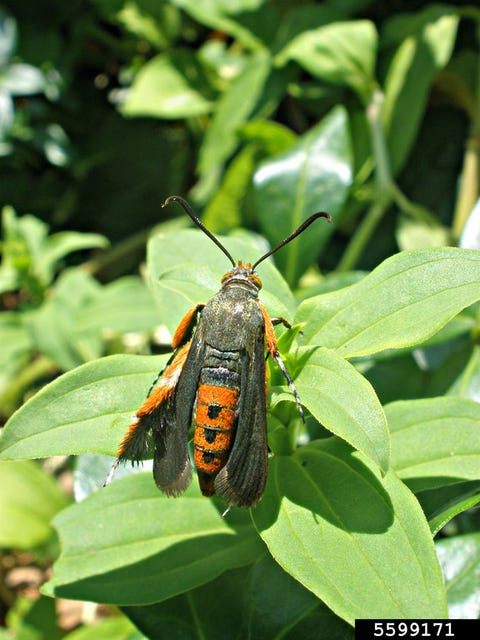
Seeds and Starts
Outside: Seeds
Although the weather has been fluctuating between weirdly hot (80 degrees F high) and severely cold (19 degrees F low), I’ve achieved surprisingly good germination with all of my direct-sown crops in the raised beds. They were sown about three weeks ago and, since then, we’ve received a lot of rain. I think the consistent moisture is primarily responsible for the success.
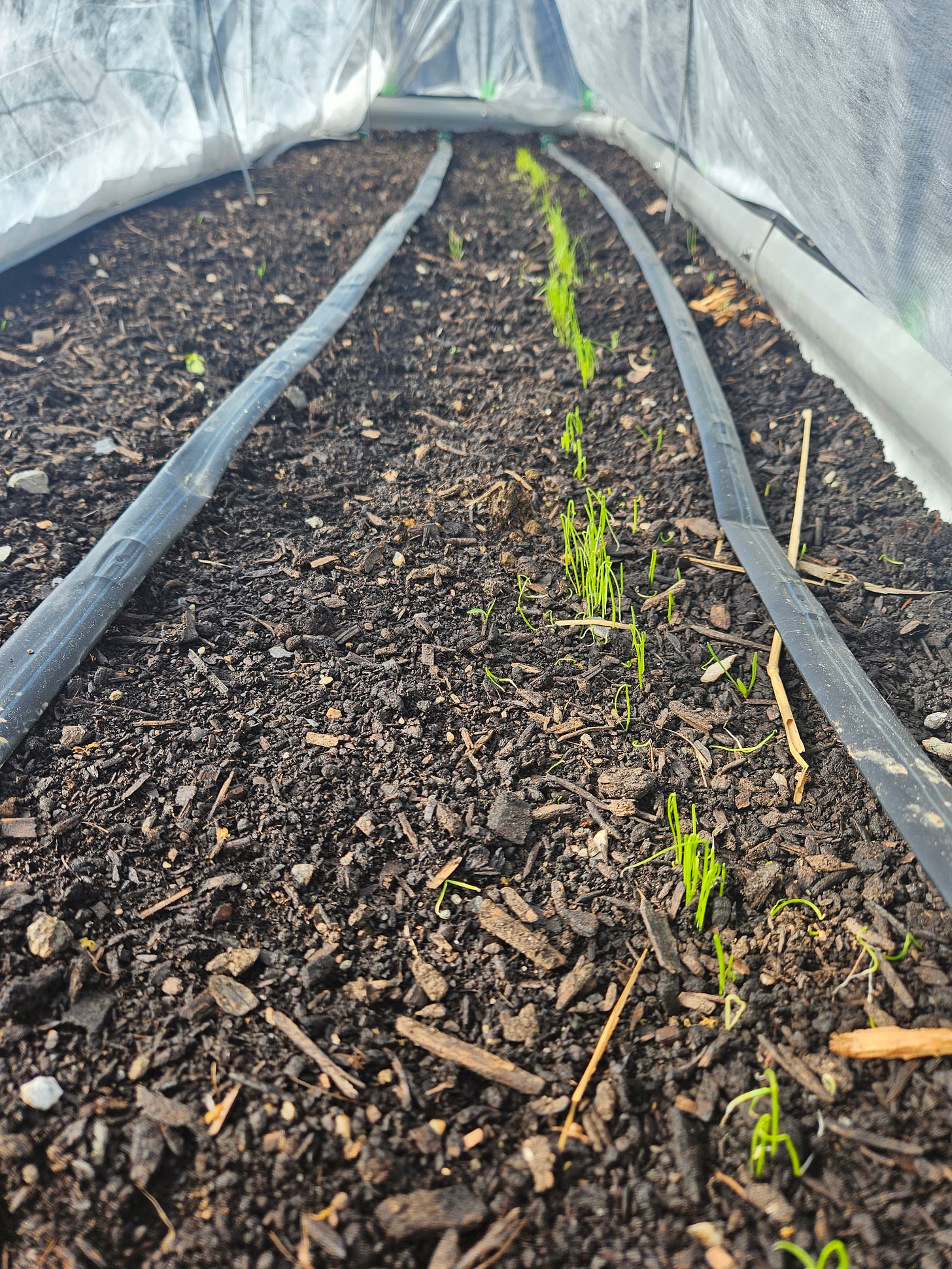
This germination may seem minor to some of you, but I am particularly pleased with it because I started these seeds outdoors two weeks prior to my originally planned start date. The soil thermometer read 45 degrees F, but I wasn’t sure if that would be enough for a satisfactory germination rate or if the seedlings could survive the temperature swings. But you never know until you try, and try I did. Even after a 19 degree F night, the seedlings did fine.
For the past few years, I’ve started most of my spring crops in the polytunnel, where the soil warms up faster. So this year’s decision to grow the entire spring crop outside—and earlier than ever—felt like a real gamble. Now, with strong germination across the board, I know I can confidently sow directly in the raised beds earlier in the season. That means harvests of leafy greens, radishes, and herbs much sooner than usual—and one more step forward in working with, not against, the natural rhythms of this new space in my garden.
Outside: Starts
One week ago, I celebrated my birthday—but I also celebrated another big transplanting day. All the leafy greens I started back in the first week of March had already outgrown the containers I potted them up into. They needed to get outside. And, honestly, I needed them to get outside, too. Watering them every other day was getting a little old.
I waited until a hard freeze passed and then transplanted them the next day. It was a misty and wet day, so I got really muddy, but the soft rain helped the starts adjust easily.
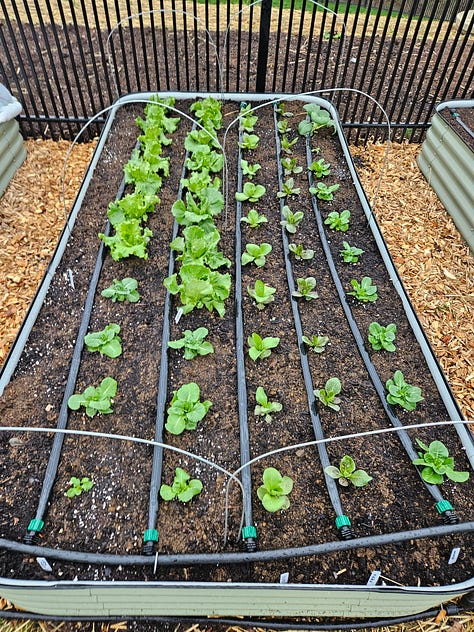
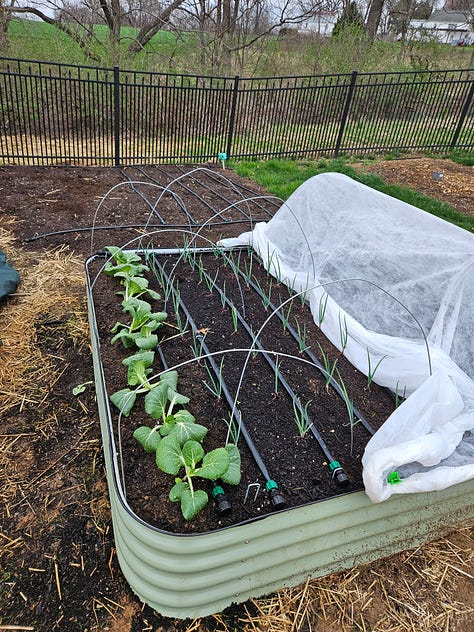
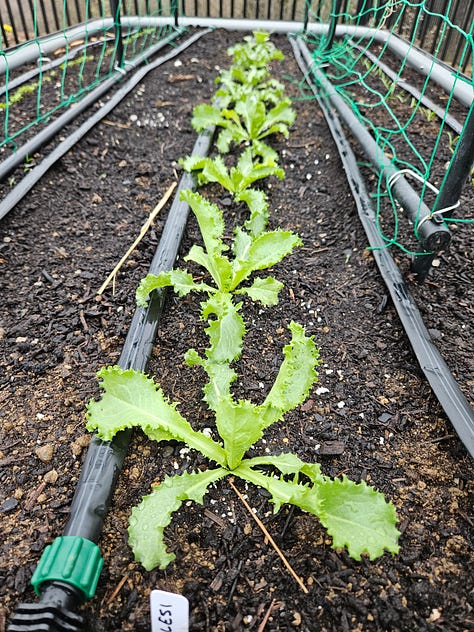
Most of the greens went into a single 8' x 4' raised bed. I tucked the two endive varieties between the cucumber trellises and planted the pac choi near my red onions. The idea is that the cucumbers will eventually provide dappled shade for the endives, while the onions might deter pests from the pac choi. I’m skeptical, but it’s worth a shot.
It’s only been a week, and the greens have already put on noticeable growth.
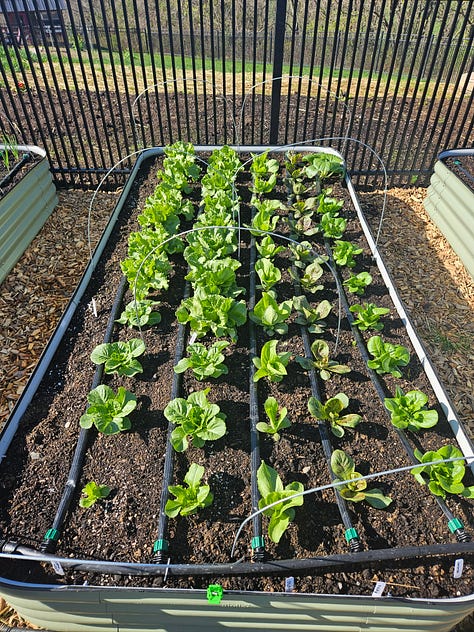
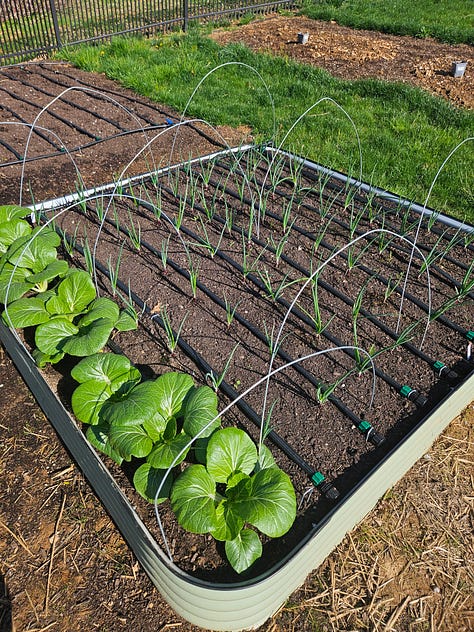
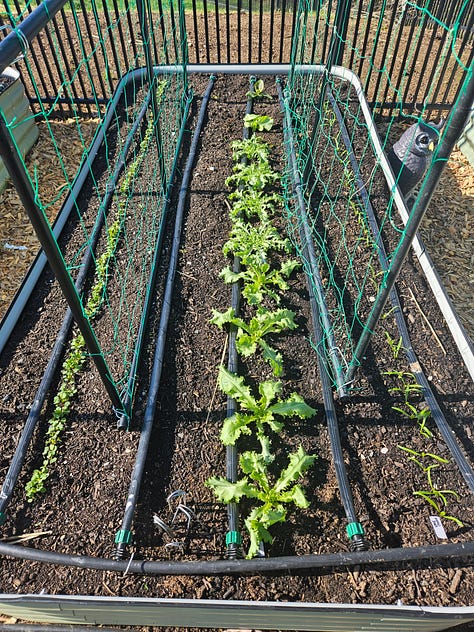
We had a couple of nights dip well below freezing, into the teens, so I covered my greens bed containing the sensitive romaine and iceberg lettuces with a plastic sheet as well as a frost blanket. The plastic completely excludes the cold winds that contribute greatly to freezing. For the other crops, including all of my alliums, I covered them only with frost blankets. In the mornings, when I removed the row cover, I was really happy to see that nothing sustained frost damage.
The forecast in the near-term looks great, so I’m hoping I won’t need to use either the plastic or frost blankets again but I won’t be putting either away quite yet.
Alliums
Note to future self: Stop freaking out about the alliums before transplanting. They’ll be fine.
The onions and shallots have grown a lot since transplanting and are as happy as can be outside. I really convinced myself for a while that I had really screwed up and killed them because their leaf tips were starting to yellow. They just needed to go outside (as always!!!).
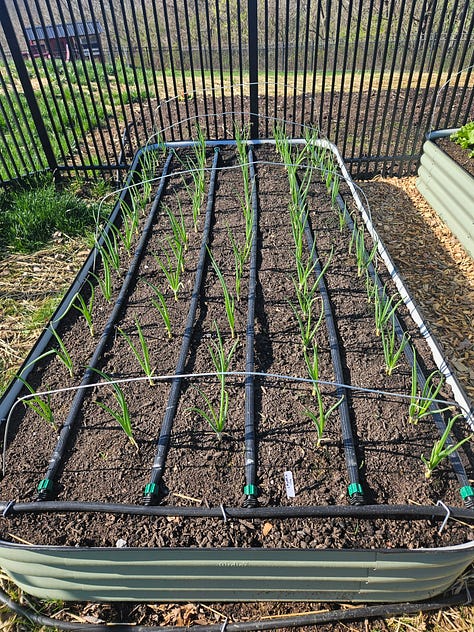
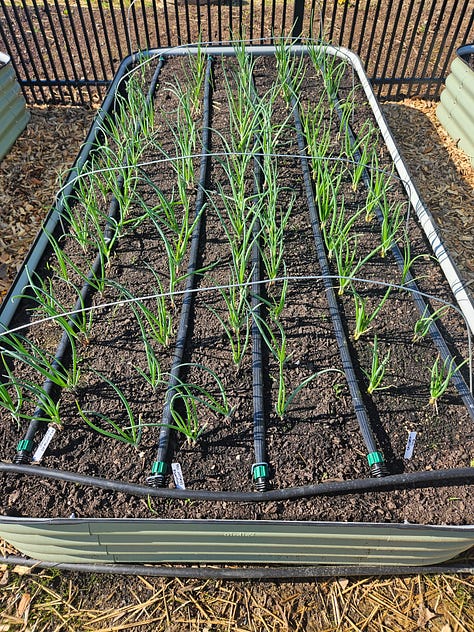
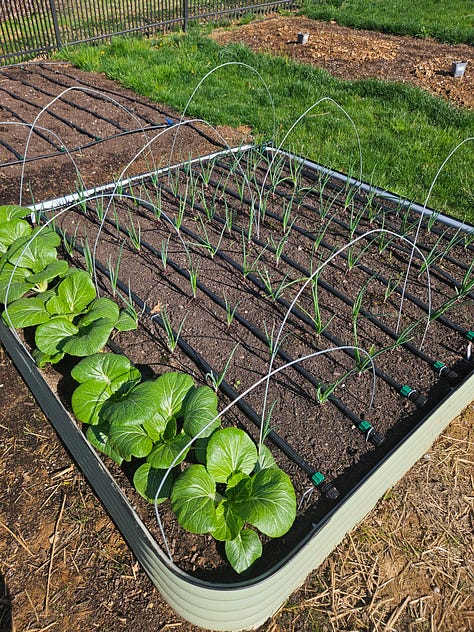
The alliums have grown so much that they’ve outgrown their low row cover of pest fabric, so I’ve removed it. At this stage, they can easily handle some pest pressure, but I’m leaving the hoops in for now in case of another hard freeze.
Inside: Starts
I’m not complaining, but it’s been a bit of a struggle keeping up with the growth in the nursery.
Since my last post, I’ve potted up my scarlet sage, eggplants, tomatillos, tomatoes, and basil. The only plants left in soil blocks are my rosemary, asters, blanket flower, and agastache and I’m planning to pot those up within the next few days.
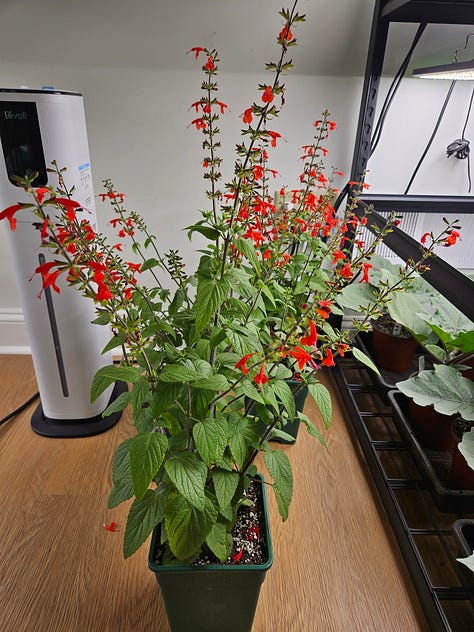
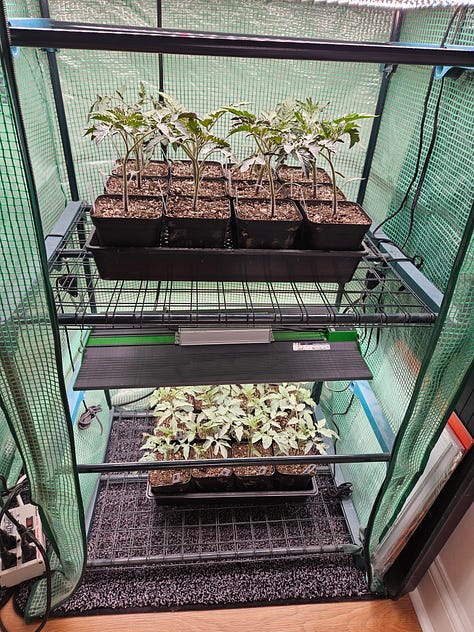
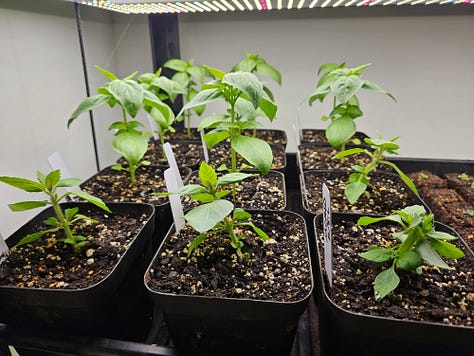
The eggplants and tomatillos are now in 6” pots while the tomatoes and basil just got upgraded to their first 4” pots. Thankfully, celery and parsley grow slowly and stay compact, because I’m completely out of space for larger pots. They can go outside a little earlier than the other summer crops. If the weather cooperates, I’ll transplant those next week.
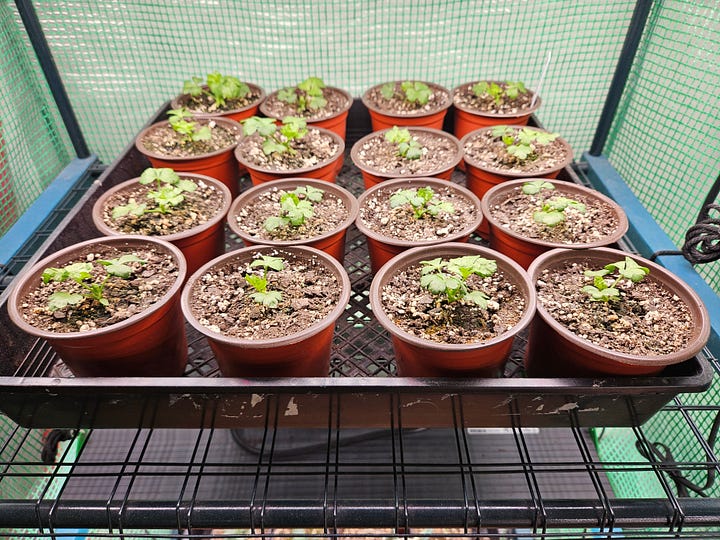
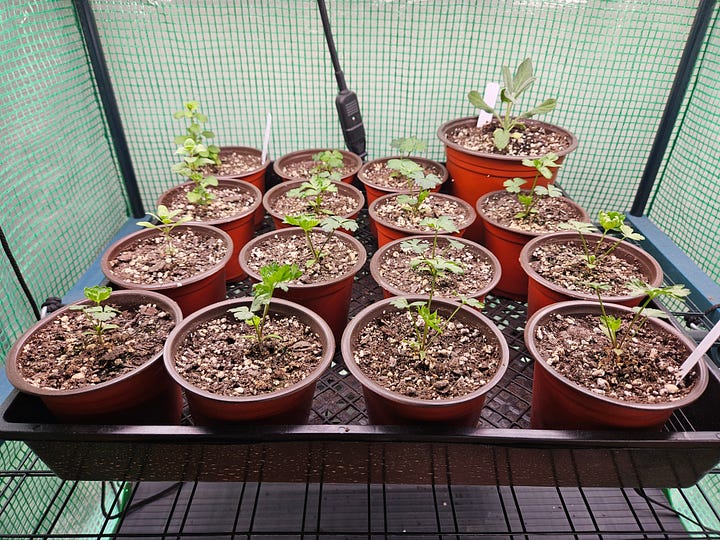
The peppers, tomatoes, and tomatillos will follow the parsley and celery into the garden a week later. The eggplants might need to wait a bit longer, depending on nighttime temps. I’m just hoping the peppers and eggplants can hang on in their pots for a little while longer—fingers crossed.
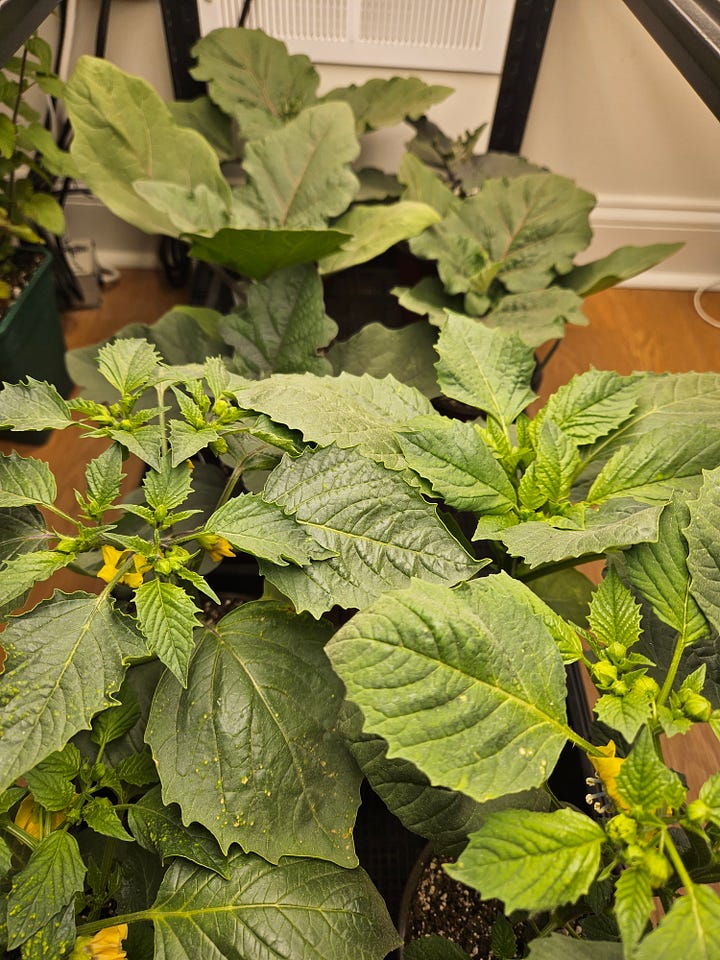
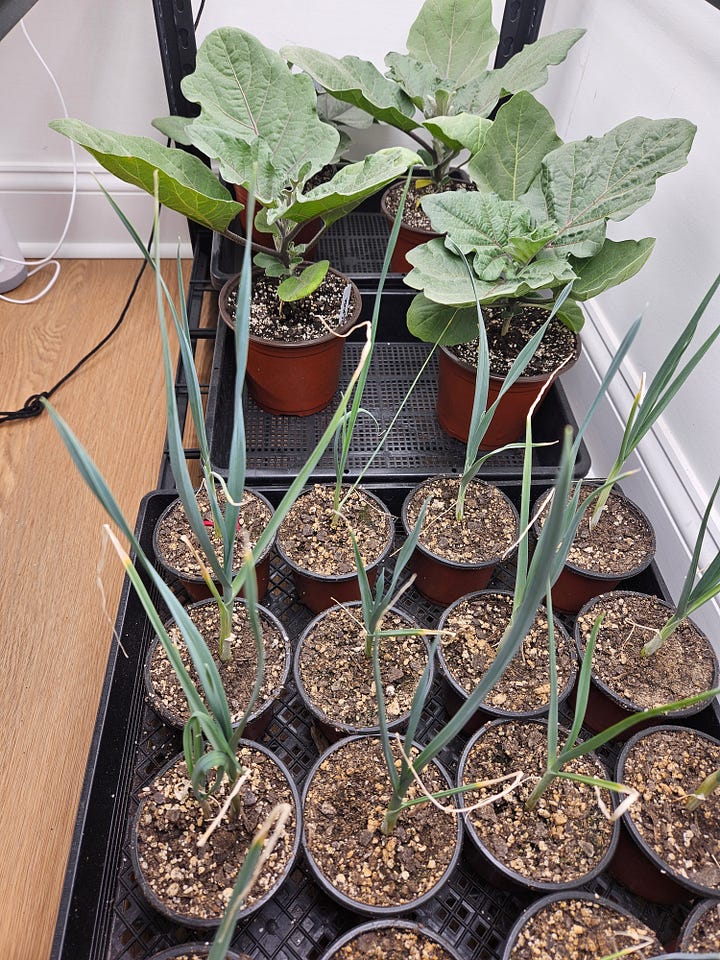
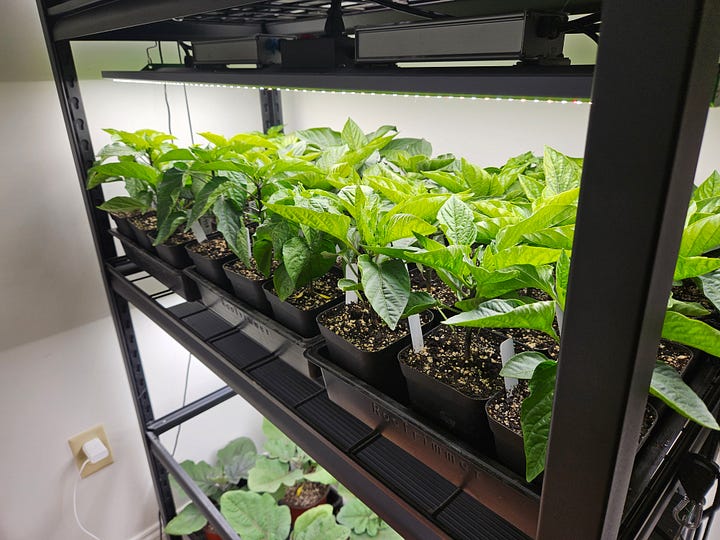
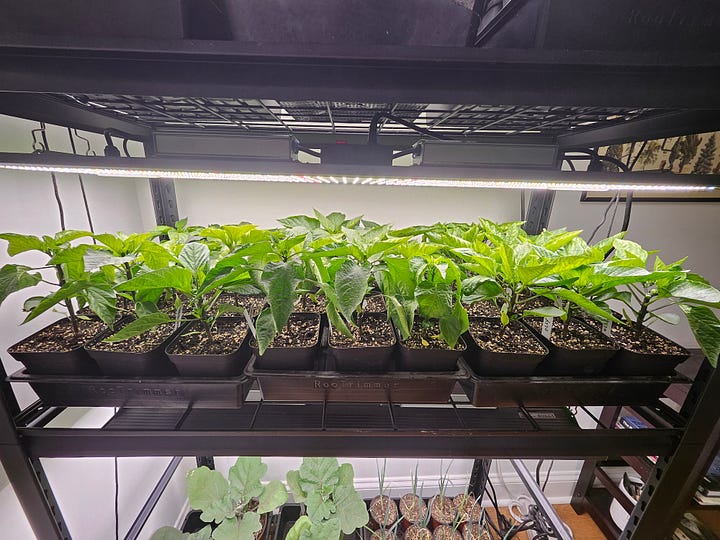
My snapdragon, salvia, calendula, licorice mint, lemon balm, mint, hollyhock, and borage plants have been consistently spending nights on the porch and will be transplanted outdoors within the next couple of days.
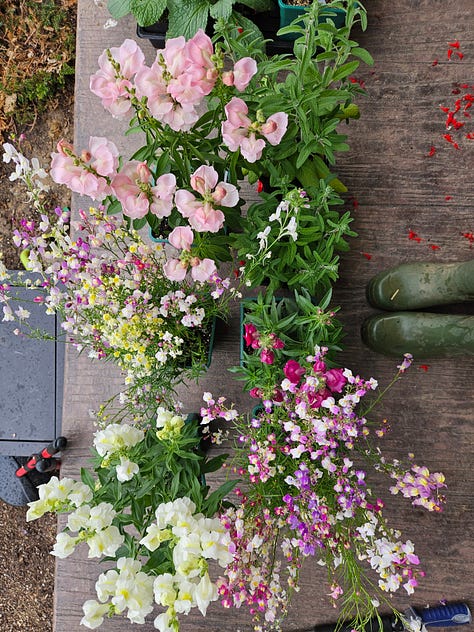
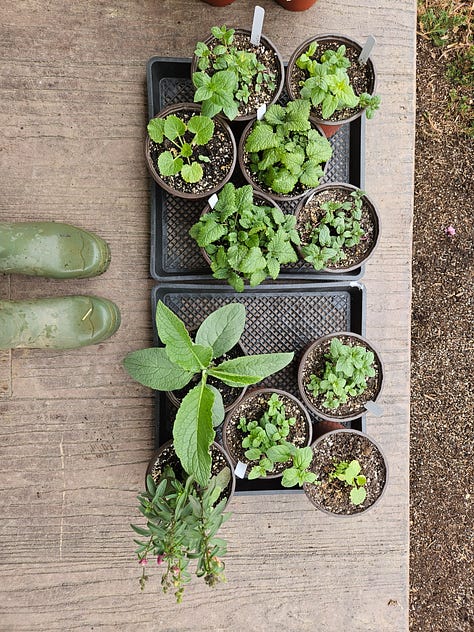
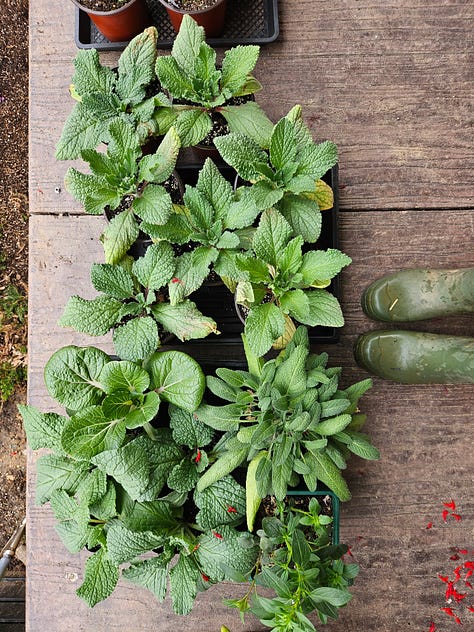
I was pretty nervous to transplant them into the garden while frost is still possible but they’ve proven themselves capable of dealing with near-freezing temperatures without breaking a (cold?) sweat.
My lavender and echinacea seedlings will stay indoors a while longer. I’ll probably get them out into the garden in May along with the other flowering plants I sowed a couple of weeks ago.
What I’m Sowing This Week
Peas are one of the easiest crops to grow—or at least that’s what I’ve heard. For some reason, I still haven’t gotten the hang of peas. I’m going to sow them this week outdoors next to a trellis I jerry-rigged out of a broken chicken run.
Last fall, I tried growing peas in the polytunnel, but they were instantly wiped out by a light frost. So this spring, I hesitated. I didn’t want to sow them early only to lose them overnight again. It might be a little late now, but I’ve decided to give it a go in early to mid-April. If the quality suffers from early summer heat, I’ll adjust my schedule next year. If you have any pea-growing tips, please drop them in the comments—I could use them!
Aside from the peas, the only new crop going into the ground this week is potatoes. I love growing potatoes. They’re dramatic—bursting out of the ground into lush growth with delicate flowers—and then swooning and collapsing like an old Hollywood actress in the summer heat, only to leave you in suspense for weeks, wondering what’s happening underground. Digging them up is the best part, of course.
This year I’m growing Burbank Russet, Yukon Gold, Satina, Elba, and Red Chieftan. I have one bed dedicated to mid-season potatoes and one for late-season potatoes so that I can dig up all of the potatoes in each bed at once when the time comes.
Believe it or not, the peas and potatoes will be the final sowings until our last expected frost date passes (May 2nd here in zone 7a). Until then, I’ll be focusing my energy on caring for my starts, hardening off seedlings, transplanting, and knocking on wood every week in hopes we avoid any surprise hard freezes.
Butterfly Chrysalis Update
Remember that black swallowtail butterfly chrysalis I found on a celery stalk last September? If not, you can read about when I discovered it below:
Metamorphosis
September twenty-second marks the official beginning of Fall and it certainly feels like it. The nights have been cool and the forecast is calling for days in the high-sixties and low-seventies. Leav…
As it turns out, the chrysalis entered diapause—a dormant state that carries it through the winter—and will eclose (emerge) this spring. I kept it outdoors to make sure it stayed cold and humid enough, but gave it some protection from wind and predators.
So far, it looks like it weathered the winter just fine. The chrysalis is still bright green and plump, and the silk hammock holding it to the celery stalk is intact. Black swallowtail butterflies usually emerge a bit later in spring, around late April to early May, but I’ve already started checking for signs of color change. When it’s almost time, the chrysalis will become mostly transparent, revealing the butterfly inside.
Right now, the bug box only contains the original celery stalk (now a withered stick), but I’m going to add one or two more vertical sticks to provide options for hanging and drying its wings. I’ll also place a paper towel at the bottom to make sure it has traction just in case it falls to the bottom during the process.
Once the chrysalis changes color, eclosure usually happens within 24 to 48 hours. When I see the process beginning, I’ll bring the box into my plant nursery to give the butterfly ideal conditions. It only takes a couple of hours for them to become flight-ready.
Once it’s ready to go, I’ll release it near my celery, parsley, or carrot plants. Since black swallowtail caterpillars feed on plants in the Apiaceae family, I’m hoping this encourages her to stick around and lay her eggs in the same garden where she grew up.
Have you ever found a chrysalis in your garden or helped raise a butterfly? I’d love to hear your stories—whether it was a swallowtail, monarch, or something else entirely. Drop a comment below and tell me what you discovered, what surprised you, or how it felt to witness the transformation!
I was a bit of a tomboy growing up. I loved watching bugs and wasn’t shy about picking them up. But I never got the chance to see a butterfly emerge from its chrysalis, so I’m really excited to finally witness it now!
Looking Ahead
Besides planting potatoes and peas, I’ve got plenty to look forward to this week. The blueberry bed needs edging—not just to keep the grass out, but also to help the mulch stay where I want it. Blueberries benefit greatly from at least 2–3” of mulch (I’ll be using leaves, thanks again Terry!) to keep their roots cool, and a clean edge will make it easier to build up and maintain that layer. After edging and mulching, I can then set up their drip irrigation system.
My borage, snapdragons, and salvias will all be moving into their permanent spots in the flower patch this week. Germination there has been excellent (yay!), but I’ll share more on that in the future. Once the rain lets up for a day or two, I’ll also finish installing the drip irrigation system in the corn patch. A few flowers and herbs in the nursery need potting up too.
I had great germination from my spinach seeds, and I’ll be succession sowing every 10 to 14 days to keep the harvests going through spring. The arugula is in dire need of thinning. And then, of course, there’s the weeding…
All in all, there’s a lot happening and even more on the horizon. I’ll have plenty to share in the days and weeks ahead.
How’s your garden coming along? Are you trying anything new this year? I’d love to hear what you’re planting, experimenting with, or just excited about—feel free to share in the comments!



